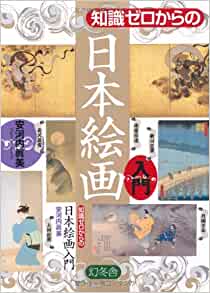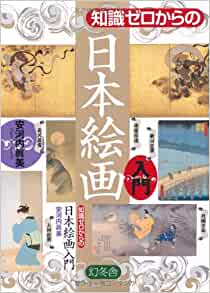安河内眞美 著 「知識ゼロからの日本絵画入門」 幻冬舎
通訳案内士の資格を取り、登録はしたものの、資格のための勉強だけで十分な知識がついているのか不安な方も多いと思います。日本をガイドするには多種多様な分野を広く知っていないと、質問された時に何と答えればいいのかわからず困ってしまうと想像して、一歩前に踏み出せなくなります。
私の場合は、たまたま所属した団体にて海外から訪日研修に来た方々に、日本を紹介する講義を行っていたので、そこでの資料をベースに知識を付けていきました。講義では広く、浅く、日本文化を他の国の文化と比較しながら、話をする構成です。浅くと言っても、講義内容だけでは薄っぺらくなりますので、自信を持って話ができるよう、各分野の最低限の学習をするため、書籍を読んだり、関連する博物館や施設に足を運びました。
その中で日本の絵画について、最初に手にしたのが本書「知識ゼロからの日本絵画入門」です。知識ゼロからのシリーズには、いろいろ分野でお世話になっています。この本では、日本の絵画をジャンル別、流派別に章立てされていて、各章にてその分野を代表する人物と著名な作品を説明してくれています。
例えば、水墨画では、雪舟の山水長巻、長谷川等伯の松林図屏風、次の狩野派では、狩野永徳の唐獅子図屏風、狩野探幽の波濤群燕図という構成です。絵画の説明に終わらず、絵師の生涯についても簡潔にまとめられているので、ガイドを行う際のエピソード挿入に役立つトピックスも見つかると思います。
私は講義では尾形光琳の燕子花図屏風の絵を用いて話をしますが、この本で学んだことを少し交えて説明しています。浮世絵の有名な絵を除いて、なかなか日本の絵画を一般の訪日外国人に案内する機会は少ないと思いますが、今まであまり鑑賞していなかった日本の絵画を改めて知る機会となり、読んでいて面白かったです。(完)

価格:1,430円
(2021/5/9 12:08時点)
感想(2件)
Introduction to Japanese Painting from Zero Knowledge” by Mami Yasukouchi, Gentosha
Although I have qualified and registered as an interpreter guide, I think many people are worried about whether they have enough knowledge just by studying for the qualification. If you don’t have a broad knowledge of various fields in order to guide people around Japan, you will not be able to take the first step forward, imagining that you will have trouble knowing what to say when you are asked a question.
In my case, I happened to belong to an organization that gave lectures on Japan to people from overseas who came to Japan for training, so I built up my knowledge based on the materials I learned there. The lecture was broad and shallow, and consisted of talking about Japanese culture while comparing it to the cultures of other countries. I read books and visited related museums and facilities to learn the minimum of each field so that I could speak with confidence.
Among them, the first one I got about Japanese paintings was this book, “Introduction to Japanese Paintings from Zero Knowledge.” I am indebted to the “From Knowledge Zero” series for their help in various fields. In this book, Japanese paintings are divided into chapters by genre and school, and each chapter explains the representative figures and famous works in that field.
For example, in the ink and wash paintings, there is a long scroll of landscapes by Sesshu and a pine forest by Hasegawa Tohaku, and in the next Kano school, there is a screen of lions by Kano Eitoku and a painting of swallow in waves and waves by Kano Tanyu. The book does not stop with the explanations of the paintings, but also briefly summarizes the life of the painters, so you can find useful topics for inserting episodes when guiding.
In my lectures, I use Korin Ogata’s painting “Iris on the folding screen” and explain it with some of what I learned from this book. With the exception of the famous Ukiyoe paintings, I don’t think there are many opportunities to show Japanese paintings to foreigners visiting Japan, but it was interesting to read this book as it gave me a chance to learn about Japanese paintings that I had not really appreciated before. (End)
Introduction à la peinture japonaise à partir de zéro connaissance” par Mami Yasukouchi, Gentosha
Bien que je sois qualifiée et enregistrée comme guide interprète, je pense que beaucoup de gens s’inquiètent de savoir s’ils ont suffisamment de connaissances juste en étudiant pour obtenir la qualification. Si vous n’avez pas une connaissance étendue de divers domaines pour pouvoir guider les gens au Japon, vous ne pourrez pas faire le premier pas en avant, en imaginant que vous aurez du mal à savoir quoi dire quand on vous posera une question.
Dans mon cas, il se trouve que je faisais partie d’une organisation qui donnait des conférences sur le Japon à des étrangers qui venaient au Japon pour se former, et j’ai donc construit mes connaissances sur la base des documents que j’ai appris là-bas. Les conférences étaient larges et superficielles, et consistaient à parler de la culture japonaise tout en la comparant aux cultures d’autres pays. J’ai lu des livres et visité des musées et des installations connexes pour apprendre le minimum de chaque domaine afin de pouvoir parler avec assurance.
Parmi eux, le premier que j’ai reçu sur les peintures japonaises était ce livre, “Introduction aux peintures japonaises de Connaissance Zéro”. Je suis redevable à la série “De la connaissance zéro” pour son aide dans divers domaines. Dans ce livre, les peintures japonaises sont divisées en chapitres par genre et par école, et chaque chapitre explique les figures représentatives et les œuvres célèbres dans ce domaine.
Par exemple, dans les peintures à l’encre et au lavis, il y a un long rouleau de paysages de Sesshu et une forêt de pins de Hasegawa Tohaku, et dans l’école Kano suivante, il y a un écran de lions de Kano Eitoku et une peinture d’hirondelle dans les vagues et les flots de Kano Tanyu. Le livre ne s’arrête pas aux explications des tableaux, mais résume aussi brièvement la vie des peintres, de sorte que vous pouvez trouver des sujets utiles pour insérer des épisodes lors du guidage.
Dans mes cours, j’utilise le tableau de Korin Ogata “Iris sur le paravent” et je l’explique avec une partie de ce que j’ai appris dans ce livre. À l’exception des célèbres peintures Ukiyoe, je ne pense pas qu’il y ait beaucoup d’occasions de montrer des peintures japonaises aux étrangers qui visitent le Japon, mais il était intéressant de lire ce livre car il m’a permis de découvrir des peintures japonaises que je n’avais pas vraiment appréciées auparavant. (Fin)
